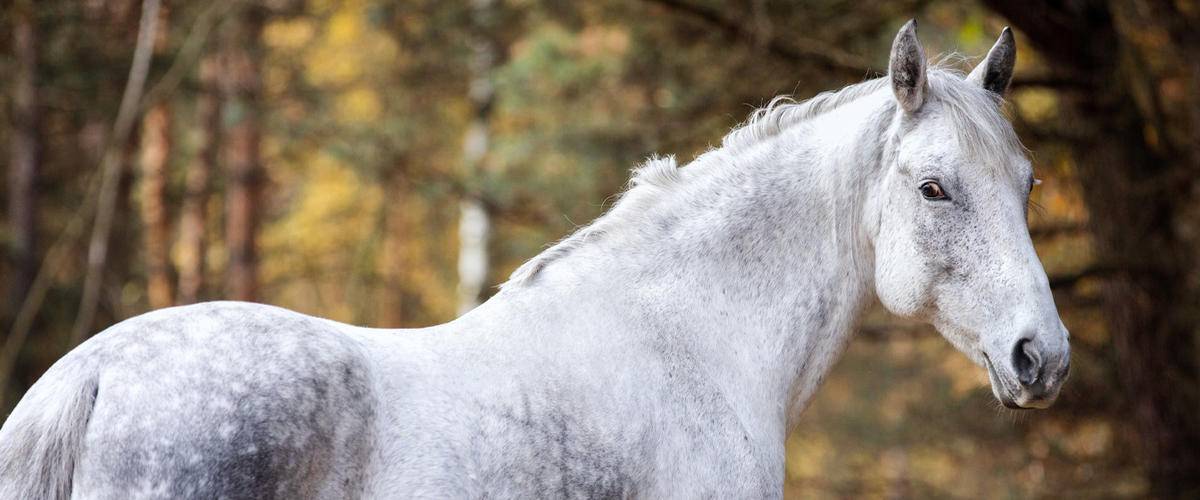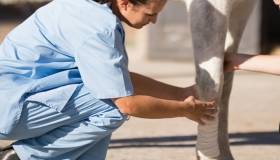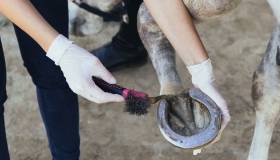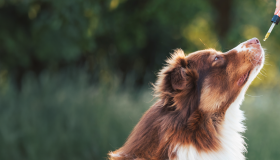
November 11, 2021 – Dr. Diehl speaks with Drs. Janny de Grauw and Diane Howard about the challenges associated with the detection and measurement of chronic pain in horses. Dr. de Grauw and Dr. Howard also discuss how they developed their pain assessment tool and how they hope this will help thousands of horses suffering from chronic pain.
Resources:
https://www.morrisanimalfoundation.org/article/osteoarthritis-pain-in-horses-questionnaire
https://www.morrisanimalfoundation.org/study/validating-pain-assessment-tool-osteoarthritis
0:00:04.6 Dr. Kelly Diehl: Welcome to Fresh Scoop Episode 38: Evaluating Chronic Pain in Horses. I'm your host, Dr. Kelly Diehl, Morris Animal Foundation Senior Director of Science and Communication. And today, we'll talk with Doctors de Grauw and Howard. Dr de Grauw has a PhD and an emphasis in joint disease pain and inflammation, and is a veterinary anesthesiologist and researcher at Utrecht University in the Netherlands. And Dr. Howard got her PhD in translation and intercultural studies that involved analysis of reading ability and questionnaire development, you'll learn why. She's here with us today, and a Master of Science in Equine Science from the University of Edinburgh. So welcome Janny and... Oh, I messed up your name, Dr de Grauw. It's Janny and Diane, right?
0:00:52.2 Dr. De Grauw: It is. [chuckle]
0:00:56.4 DD: So, before we get started, let's start with you, Janny. Tell me a little bit about yourself and what led you to veterinary medicine.
0:01:04.2 DG: Yeah. Well, basically, I am one of those classical stories of the girl that was always hanging around with her dog, her horses and any other pets that I could find, and then I had an uncle graduate as a vet when I was 11, and I joined his rounds and I realized that this was a job that would forever keep me satisfied in terms of needing to figure out what was wrong with this animal, laying these pieces of the puzzle, talking to owners trying to not just help an animal get better but also these owners, and it has kept me interested and motivated for this job, [chuckle] and I think I will be for the rest of my life.
0:01:48.1 DD: That's great. So how about you, Diane? What kind of got you interested in equine science?
0:01:56.2 Dr. Howard: Well, I've always loved horses, but I did my undergraduate and graduate work in languages, which allowed me to travel a lot, and then developed expertise in medical translation basically for humans, but at the same time, I continued writing and working with horses, and I decided to transition to actually doing what I really like doing, which is translating scientific knowledge into practical knowledge that people can use. I've been doing that from language to language, but now I'm doing it from scientific studies in horses to something that owners can really use to help manage their horses in a better way, for better equine welfare and happier human participants.
0:02:54.9 DD: Awesome. And I forgot to mention that Diane's actually joining us from France, so this is a very internationally flavored program today. And thanks you guys, because what our audience doesn't know is we're recording this and it's nighttime where they are, or later in the day, so thanks again for joining. So Janny, before we get into the details of your project, could you start with an overview of chronic pain in horses? And it's a big question. Causes, challenges, cost to the owner and horse.
0:03:27.2 DG: It is a big question. I could probably fill multiple podcasts on this topic, but I'll try not to. What I think is really important to realize about chronic pain is that it really differs from acute pain. It's not like acute pain that just lasts longer, so I think the concept of chronic pain, if you want to make the distinction with acute pain, then start by thinking about acute pain, that's about how the pain feels. You hit your thumb with a hammer, it's right there, this is how much it hurts, it's either throbbing or stinging or stabbing, and you can really describe it accurately. Now, the difference with chronic pain is that acute pain is about how the pain feels, but chronic pain is about how the pain makes you feel, so it really affects emotions, it affects how you perform your average daily life, and this is very much also true for animals.
0:04:31.3 DG: Now, the problem is that usually chronic pain might be more subtle, there might be a different background to it, so it might be multifactorial, which is a term that it might sound vague, but usually that's the reality of these cases. And so, diagnosis of the problem is usually one of the biggest challenges. How do you identify animals in chronic pain? Because they will not be able to self-report on it. Now, if we talk about causes, which I think was also one of your questions, like, ‘What do I need to think about with chronic pain in horses’? A big, big issue obviously, so the majority of chronic pain cases may be orthopedic, so think about osteoarthritis joint pain, but also tendon, tendonitis, bone issues, back muscular issues. These are really... They have a high incidence and prevalence in the equine population. But we shouldn't rule out other sources like chronic dental pain, ocular, so eye disease. There's quite some of that going on as well, as well as a bigger mixed group of internal causes.
0:05:49.6 DG: Now, I already said identification is one of the major challenges. How do you either identify or rule it out when you suspect that there is something wrong with your horse? How do you then come to the source of the pain? How bad is it? But another thing that's really particular with chronic pain in horses is how do you actually measure efficacy of anything you're trying to treat it with? So, is your horse doing better? How do you know? You might have been trying lots of different therapies at home, when do you need to seek expert advice? Actually, who is the expert here? So, there's a lot there that is a challenge, and I think also when you're dealing with a horse with chronic pain and that might be chronically lame, expectation management of the owner is also really important. So, acute pain is treatable, chronic pain is usually about learning to cope with it and managing it as well as we can.
0:06:49.9 DD: And you just mentioned this, but can you dive a little deeper into why it's important to study chronic pain in horses?
0:07:00.6 DG: Yeah. I think actually, there's a lot of very obvious reasons. Any horse owner will want to do good for their horses. Human caretakers have this ethical responsibility to take good care of their horses, and if you think about the Five Freedoms or the AWIN Protocol, all of them stipulate we need this horse to be free from pain, free from the stress and healthy. Well, health is really one of the underlying animal welfare aspects. But there's a lot of other reasons why it's so important to study chronic pain in horses; they live to quite an old age, they might accrue painful conditions over their life, they are a prey species, they're good at hiding pain, and actually, I think Diane will also really echo this, is that humans aren't as good at reading those pain signs in horses as we might like to think we are. Right, Diane?
0:08:03.2 DH: That's true. When we started this study, we were basing it on an earlier chronic pain study in dogs, and the original plan was to simply mirror the dogs study. We found that that wasn't really possible because humans love their dogs and they love their horses, but they're with them in very different ways. A human might notice, and will notice that their dogs can't get on the couch anymore or can't jump into the car, and they'll say, "Oh, the poor dog probably has a joint problem and needs to go to the vet." Unfortunately, some owners, because of tradition in the equine world, it's certainly not from any ill intent, but just the way horses have always been kept, there's a tendency instead of to say, "Oh, Champion can't jump that anymore because he hurts." It's, "You should make him get over that, he's being stubborn." So that gives us really even more of a push to develop something to help people step away from anthropomorphizing the horse as stubborn or ill-natured or something, and realizing that there's probably a real physical issue.
0:09:38.1 DD: Okay. So, the next question I had for both of you and you're again, you're leading me very nicely into it, so I'll start with you, Janny. What are some of the challenges you found in studying pain in horses, specifically chronic pain?
0:09:52.9 DG: Yeah. Well, the very big obvious one is obviously the lack of self-report, and that's just not just in horses, it's try and identify or study pain in any animal species or in any nonverbal subject means that you're always left to observations. And it's also true for humans, if we want to figure out how much pain someone else is in, it is always... We are putting a layer of observation and interpretation on top of somebody's actual real pain experience. So, there's no gold standard readout for the amount of pain anyone or any animal is in. So, the same stimulus may cause different pain sensations and different pain severity. In humans, they can self-report on it, we know it from them, but it's likely also true in animals.
0:10:51.3 DG: Now, when we try and make observations, we are going to be influenced by our own biases, by our own beliefs, by our own experiences, but the horse is also going to be influenced by the presence of an observer, by anything in the surroundings, cues; we might be leading them on, even though we don't mean to. Now, in the scientific field of studying pain, there's also the aspects of, ‘Are we going to study clinical pain’? So, are we going to start with a population of horses that is really suffering from spontaneous disease? That is obviously the most clinically relevant population to tackle. Those are the horses that are suffering from these painful conditions, but at the same time, we usually struggle to find a group that's very homogenous for us to study. When did this painful condition start? What exactly started the pain in a joint? Is it originating from the capsule more, or from some ligaments? Is it originating from synovitis?
0:11:57.1 DG: It might be more in one horse than the other, so it really, really... That makes it difficult, and I'm very sorry to also have to say that there's also really a lack of funding available for fundamental studies of pain in horses. So, pain is very, very central to many diseases that are very important to horses and to their owners, like osteoarthritis, like tendonitis, like dental disease. However, the pain aspect usually is understudied, even though it might be the most relevant to both the horse and the owner.
0:12:32.9 DD: And I'm going to have Diane pick this up now. In the challenges of constructing a valid questionnaire that addresses some of the things Janny said, as Janny mentioned, and we've struggled with small animals, where you have an observer who's going to be trying to make some judgement on pain and also the unique aspects of equine pain that you had to take into account, Diane, when you worked on the questionnaires for this study.
0:13:09.9 DH: Happily, very, very good work has been done on the Horse Grimace Scale and recognizing through facial expression and posture ways of recognizing pain. So, one of the challenges was to go through those studies and find signs that were both demonstrative of pain, but also relatively easy for the lay public to see. Many people don't realize that distance between ear tips is a real signal, if the ears aren't moving, of pain and many of the people I've spoken to while I've been interviewing them for this study have said, "Oh, nobody ever told me that. I didn't know." So, the challenge was finding these fairly easy to recognize items and put them together in a way that was easily accessible; and by easily accessible, we were measuring reading level. So, we checked everything we did to make sure that a 12-year-old can do this, anyone with a sixth or seventh grade education in the US system can read and understand this system and we did check it with... Some of our participants did have learning disabilities and really had no trouble with it. So that's one thing you want for solid questionnaire development.
0:14:56.9 DH: The other is that you want items that are going to cover all your bases in effect, but not be overwhelming. So, we set based on the brief pain questionnaires in humans and dogs a cap of 15 items that could be done within five minutes and then we did Cronbach's... So, a factor analysis of, "Did we really hit our target?" We had. In fact, it's a little bit repetitious. Statistically we could take a few questions out, but then looking at questionnaire development, that would eliminate some of the face value, the fact that people feel that they're giving enough information because if we did it in maybe eight questions people might think, "Well, they say it'll work, but I don't think so." Fifteen seem to be giving people a very solid feeling of, "There's nothing I'd want to take out, but maybe I want to add something."
0:16:12.8 DD: Right. And I think for people who are listening, just really to add this, questionnaire development is an art form in itself. I think we're realizing that, that we can lead people inadvertently to certain answers. So, I think there's a recognition this is a really important and a specialized area because otherwise it can be invalid. And I think all of us have taken a few questionnaires where we're like, "Didn't they just kind of ask this?" Just to get at information a different way and we know that we could answer differently. So, thanks, Diane, for talking about that because I think we don't think about that. We go to Survey Monkey and make a few questions and it's not like that. It's much more in depth. So Janny, back to you, what do you hope to accomplish with your study?
0:17:02.9 DG: Yeah. Really, really good question obviously. Well, the first thing I think we're already accomplishing even just with this podcast, is raising the awareness of the problem of chronic pain in horses, that it's there, that people struggle to identify it maybe, that they struggle to find ways to cope with it and to have valid read-out parameters to tell them whether the horse is doing worse or better or stable.
0:17:32.4 DG: So what we're hoping to accomplish is that we will get owners a tool that is easy to use, that is validated, so meaning that it indeed encompasses that realm of chronic pain that we're trying to capture with this tool and that they can use repeatedly in their own horses to track their condition over time and that it helps them in knowing when to maybe plan a vet consultation, that it already before they even are pointed that way, it makes them spend time systematically assessing aspects of equine behavior that previously they may not have recognized as subtle signs of pain. And I think when we're putting out this tool to a bigger audience, just like the Horse Grimace Scale and a lot of the Acute Pain Scale work has done, it raises awareness in such a way that it really becomes this oil puddle sort of thing. It just spreads and it keeps spreading in a good way that it really reaches out to everyone who has all these great intentions with their horses and then has the tools to now also really not mistake a certain kind of behavior for something it might not look like.
0:18:54.9 DD: Right. Walk us a little bit through... First I'm going to have Janny talk about your methods and then, Diane, I'm going to have you talk briefly about how you constructed the questionnaire. So Janny, you first on the overall.
0:19:09.9 DG: Yep. Diane basically... When we set out with the project, I initially had the idea to follow the same steps as they did for the Canine Brief Pain Inventory. The canine one was modeled after the human one. And like Diane already indicated before, people spend time with their dogs in a very different way. Most people don't have their horse around the house, so obviously you need to vary your approach a little and some items might not work as well. So, during tool development, Diane sat down with several groups of people, had interviews, focus group meetings, expert consensus meetings to come to a set of items and a set of criteria that would need to be in there for this questionnaire.
0:20:04.0 DG: And those experts' consensus meetings, the experts there would vary across as wide a range of fields that we felt were important as possible. So, there would be orthopedic surgeons there, there would be anesthesiologists there, but there would also be equine body workers there, there would be zoo animal and exotic animal medicine specialists there because they always need to interpret animal behavior where there is very little scientific evidence backing some of it up, probably. And so, through these interviews, focus groups, expert consensus meetings, the questionnaire got its shape, and then people would have feedback rounds on the tool as it was being developed. And we picked a format, and I think this is where I'm going to leave it to Diane where we had a number of items and we had scales for each item, and the eventually developed tool was then put to legibility study. And at this point, we're trying to validate the tool in a known groups approach. So, animals, horses with chronic pain, and those that are... Well, guaranteed, there are no guarantees in life, but are deemed sound also by vet expertise, and we're getting owners to test and retest their horses and at set intervals.
0:21:27.3 DH: So, what we started with was a really thorough literature review of behavioral signs. That was the first step, so we developed a library of several hundred articles and extracted items from that, then we had focus group studies where we asked open-ended questions as what would make you call a vet, what would make you think your horse might be in chronic pain, might have osteoarthritis. I analyzed the words people used, so some of them when we got to the expert level, people would say, "Well, that's subjective," but that was what horse owners were using. For example, one of our items is, Is your horse enthusiastic about daily activities? This is not a scientific statement, but it seemed to resonate with almost all of the owners. So after the focus group studies, I put together the questionnaire and then sent it to experts in lameness and some of the fields that Janny mentioned for further comment and refinement of language again, so we were going to get it to align between lay language and scientific language, then we did the legibility testing on it, and ran it by 25 people with vet who were either the owners or the caregivers of horses with vet diagnosed of osteoarthritis, and 24 of them found it very useful.
0:23:19.5 DH: So, at this point, we're in the test/retest stage. Are you going to get consistent answers if nothing has changed? So, we have a very short period of two days because nothing should change over a two-day period. And we're also running it in a group of horses known not to have osteoarthritis, and we will compare the results from those two groups. This is exactly the same procedure that is used to validate human pain scales, and that was used for the canine brief pain inventory.
0:24:01.9 DD: Okay, so Janny, what do you think you're going to find as you are moving through this? And then I'm going to actually ask you to predict what would you do next based on your findings?
0:24:18.7 DG: Good one. Yeah, well, if we'd already know completely what we'd find, then the obvious answer for research it would be like, "Well, then we'd just stop, then it wouldn't be research." Right?
0:24:27.5 DD: Right.
0:24:28.6 DG: I bet we'll also end up with some more questions because that's always the outcome of most work, but certainly we hope to find that this is a tool that can discriminate, not only discriminate horses with chronic pain from those without, but a tool that is sensitive to changes in baseline pain experienced by these horses, and that it is a tool that owners indeed consistently can use and can consistently fill out that's not poorly interpretable, so it's straightforward, and that it will contribute to actual daily management of horses by their owners and not be a tool that is only used in scientific investigations because we want to bring the scientific and the lay press more closely together on this aspect.
0:25:22.9 DG: One of the findings that Diane is already seeing as we have... Right, Diane? We're in the stage of having questionnaires coming back to Diane at this point, where there were horses that... Where a management change had occurred over a couple of weeks period, and indeed it seemed to be responsive, the tool seemed to be responsive to those management changes. Now, that's obviously something you would like to see because if the owner says, "Well, generally, I consider the horse to be worse than it was two weeks ago," you would like to see that mirrored by your scores, that would be the premise. Also, Diane was finding, and we were just discussing this before, that some owners will say, "I actually think my horse is quite happy. However, it cannot move as it did before." So there seems to be a bit of a disparity need sometimes between the pain aspects and the movement or mobility aspect, and it would be really, really interesting to see more of these responses come in and to see if there's a disparity there, if there's more that we can do to tease that out.
0:26:35.6 DD: Okay, it sounds really interesting, and I know pain is really a hard thing to measure objectively. What do you hope... And you alluded to this, the results of your study will do for people who have horses who are struggling with chronic pain.
0:26:55.8 DH: We hope that it will first facilitate communication with the vet because, this has been pointed out in several studies, the vet comes to look at the horse and the horse is going to have sometimes a startled reaction, maybe the horse finds the vet aversive because of previous necessary treatment, but this way the vet has a record to look at of what has been going on with the horse and if there's been a certain medication prescribed whether or not it's having the desired effect. If the horse is getting higher pain scores over the course of two months' treatment with a certain regimen, you know it's time to change that. So, we hope that it will really help with managing quality of life and also owner/vet communication that will improve the welfare of the horse.
0:28:02.5 DD: Yeah, that's really great. I think it's a hard thing sometimes even for veterinarians to assess pain. Do you think this is something a vet could use that goes out and at point one they do one... They fill it out themselves and then maybe they go out to see the horse again and they can fill it out and the owner? Or is this really more owner-centric?
0:28:28.8 DG: Well, I think it's important to realize that it is focused... It really has been developed to be used by the owner. So, there's items there that a vet at a regular consultation would not be able to score.
0:28:41.8 DD: Okay.
0:28:42.8 DG: Also, because it asks questions like, "Can your horse do this as it did before, or it is no longer as happy as it would?" And that would be harder for a vet who is only brought into consultation every so often or maybe even for a first time. So, I think it's really important that we realize there are pain scales out there for vets to use not validated yet for chronic pain and this is really a tool that specifically has been developed for owner assessment of pain. And I think Diane will definitely from her language scientific background also assert that these tools are specific to a certain target audience. Right, Diane?
0:29:30.3 DH: Yes. You really don't need to talk to vets at a 7th grade level.
0:29:36.7 DD: Right, right, right. Yeah, no, I was just curious if that... But I think maybe in combination with the veterinary exam and the veterinarian's observation I think are going to be really, really important. So just to wrap up, Janny and Diane, what is your take-home message for horse owners and equine veterinarians as far as what you're finding and what you hope to accomplish?
0:30:06.7 DH: I think for me, it's that owner record-keeping is really vital for horse welfare. At the beginning of this process, I was quite inspired by friends that work in the zoological community who shared some of the forms that they use to track their animals because, again, you only have observation to determine the pain level. So, my hope would be that owners will learn to look more carefully at their horses, but also really keep a record of what's going on with the animal so that they can catch changes sooner. We can't cure arthritis, but we can certainly do some things to slow the process down and to address the pain. So that would be my main hope for this.
0:31:05.7 DG: Yeah. And I can only really echo that. Well, a take-home message, that's difficult to give because there are so many aspects of this. I think one is that animal behavior, and particularly horse behavior, is a language for them in itself and we're trying to capture it in our language in a questionnaire for the owner, but it means it takes a good interpreter and we hope that this tool is doing that for these owners. And I also believe that the time spent in systematically looking at your horse and looking for those items that we will have included in our tool and that will hopefully by the end of this project will have been validated as this is why these items need to be in there because they correlate and they are sensitive to change, that it really helps people get a grip of the pain situation in their horse, how it develops, and that it actually makes the horse and rider interaction and the caretaker interaction even more fulfilling and better for both involved.
0:32:18.3 DD: I'm really excited about this study. And I think Janny also, your explanation at the beginning of how to view chronic pain versus acute pain was really helpful for whether you have a cat or a dog or you're watching your elderly mom or whatever to remember that they're quite different and should not be... I think we've treated them always as a lump and put them together, and I really appreciate that distinction.
0:32:50.7 DD: Well, guys, that does it for this episode of Fresh Scoop. And once again, thanks to Janny and Diane coming to us from Europe, very exciting, and joining us tonight. We'll be back with another episode next month that we hope you'll find just as informative. We know the science of animal health is ever-changing and veterinarians need cutting edge research information to give their patients the best possible care and that's why we're here. And you can find us on iTunes, Spotify, Google Podcasts and Stitcher. And if you liked today's episode, we always ask folks to give us a moment to rate it so other people can find us. And if you want to learn more about Morris Animal Foundation's work, go to morrisanimalfoundation.org and there you'll see just how we bridge science and resources, which is our mission statement, to advance the health of animals. And you can follow us on Facebook, Twitter and Instagram. And I'm Dr. Kelly Diehl and we'll talk soon.




